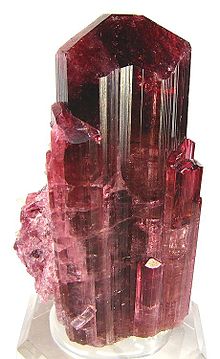
Amethyst is a violet variety of quartz. The name comes from the Koine Greek αμέθυστος amethystos from α- a-, "not" and μεθύσκω methysko / μεθώ metho, "intoxicate", a reference to the belief that the stone protected its owner from drunkenness. Ancient Greeks wore amethyst and carved drinking vessels from it in the belief that it would prevent intoxication.
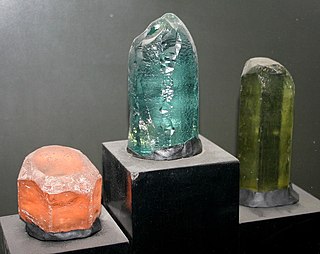
Beryl ( BERR-əl) is a mineral composed of beryllium aluminium silicate with the chemical formula Be3Al2Si6O18. Well-known varieties of beryl include emerald and aquamarine. Naturally occurring, hexagonal crystals of beryl can be up to several meters in size, but terminated crystals are relatively rare. Pure beryl is colorless, but it is frequently tinted by impurities; possible colors are green, blue, yellow, pink, and red (the rarest). It is an ore source of beryllium.

A gemstone is a piece of mineral crystal which, in cut and polished form, is used to make jewelry or other adornments. However, certain rocks and occasionally organic materials that are not minerals are also used for jewelry and are therefore often considered to be gemstones as well. Most gemstones are hard, but some soft minerals are used in jewelry because of their luster or other physical properties that have aesthetic value. Rarity and notoriety are other characteristics that lend value to gemstones.
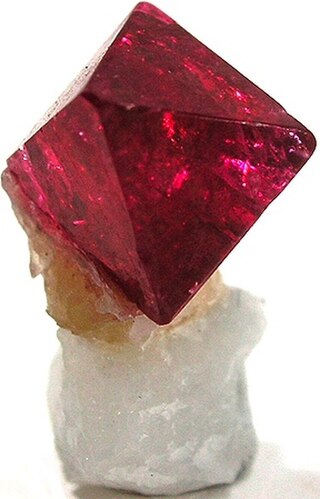
Spinel is the magnesium/aluminium member of the larger spinel group of minerals. It has the formula MgAl
2O
4 in the cubic crystal system. Its name comes from the Latin word spinella, which means spine in reference to its pointed crystals.

Sapphire is a precious gemstone, a variety of the mineral corundum, consisting of aluminium oxide (α-Al2O3) with trace amounts of elements such as iron, titanium, cobalt, lead, chromium, vanadium, magnesium, boron, and silicon. The name sapphire is derived via the Latin sapphirus from the Greek sappheiros (σάπφειρος), which referred to lapis lazuli. It is typically blue, but natural "fancy" sapphires also occur in yellow, purple, orange, and green colors; "parti sapphires" show two or more colors. Red corundum stones also occur, but are called rubies rather than sapphires. Pink-colored corundum may be classified either as ruby or sapphire depending on locale. Commonly, natural sapphires are cut and polished into gemstones and worn in jewelry. They also may be created synthetically in laboratories for industrial or decorative purposes in large crystal boules. Because of the remarkable hardness of sapphires – 9 on the Mohs scale (the third hardest mineral, after diamond at 10 and moissanite at 9.5) – sapphires are also used in some non-ornamental applications, such as infrared optical components, high-durability windows, wristwatch crystals and movement bearings, and very thin electronic wafers, which are used as the insulating substrates of special-purpose solid-state electronics such as integrated circuits and GaN-based blue LEDs. Sapphire is the birthstone for September and the gem of the 45th anniversary. A sapphire jubilee occurs after 65 years.

Topaz is a silicate mineral of aluminium and fluorine with the chemical formula Al2SiO4(F,OH)2. It is used as a gemstone in jewelry and other adornments. Common topaz in its natural state is colorless, though trace element impurities can make it pale blue or golden brown to yellow orange. Topaz is often treated with heat or radiation to make it a deep blue, reddish-orange, pale green, pink, or purple.
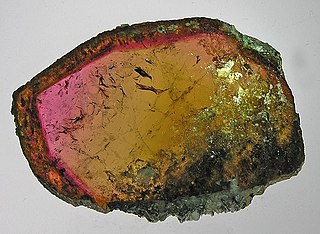
Tourmaline is a crystalline silicate mineral group in which boron is compounded with elements such as aluminium, iron, magnesium, sodium, lithium, or potassium. This gemstone comes in a wide variety of colors.

A ruby is a pinkish red to blood-red colored gemstone, a variety of the mineral corundum. Ruby is one of the most popular traditional jewelry gems and is very durable. Other varieties of gem-quality corundum are called sapphires. Ruby is one of the traditional cardinal gems, alongside amethyst, sapphire, emerald, and diamond. The word ruby comes from ruber, Latin for red. The color of a ruby is due to the element chromium.

Peridot, sometimes called chrysolite, is a yellowish-green transparent variety of olivine. Peridot is one of the few gemstones that occur in only one color.

The mineral or gemstone chrysoberyl is an aluminate of beryllium with the formula BeAl2O4. The name chrysoberyl is derived from the Greek words χρυσός chrysos and βήρυλλος beryllos, meaning "a gold-white spar". Despite the similarity of their names, chrysoberyl and beryl are two completely different gemstones, although they both contain beryllium. Chrysoberyl is the third-hardest frequently encountered natural gemstone and lies at 8.5 on the Mohs scale of mineral hardness, between corundum (9) and topaz (8).
Lustre is the way light interacts with the surface of a crystal, rock, or mineral. The word traces its origins back to the Latin lux, meaning "light", and generally implies radiance, gloss, or brilliance.

Onyx primarily refers to the parallel-banded variety of chalcedony, an oxide mineral. Agate and onyx are both varieties of layered chalcedony that differ only in the form of the bands; agate has curved bands while onyx has parallel bands. The colors of its bands range from black to almost every color. Specimens of onyx commonly contain bands of black and/or white. Onyx, as a descriptive term, has also been applied to parallel-banded varieties of alabaster, marble, calcite, obsidian, and opal, and misleadingly to materials with contorted banding, such as "cave onyx" and "Mexican onyx".

Rhodochrosite is a manganese carbonate mineral with chemical composition MnCO3. In its pure form (rare), it is typically a rose-red colour, but it can also be shades of pink to pale brown. It streaks white, and its Mohs hardness varies between 3.5 and 4.5. Its specific gravity is between 3.45 and 3.6. It crystallizes in the trigonal system, and cleaves with rhombohedral carbonate cleavage in three directions. The crystal structure of rhodochrosite is a rhombohedral system, which is a subset of the trigonal system. The carbonate ions (CO3) are arranged in a triangular planar configuration, and the manganese ions (Mn) are surrounded by six oxygen ions in an octahedral arrangement. The MnO6 octahedra and CO3 triangles are linked together to form a three-dimensional structure. Crystal twinning often is present. It is often confused with the manganese silicate, rhodonite, but is distinctly softer. Rhodochrosite is formed by the oxidation of manganese ore, and is found in South Africa, China, and the Americas. It is officially listed as one of the National symbols of Argentina.
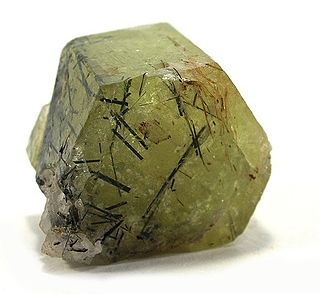
In mineralogy, an inclusion is any material that is trapped inside a mineral during its formation. In gemology, an inclusion is a characteristic enclosed within a gemstone, or reaching its surface from the interior.

Elbaite, a sodium, lithium, aluminium boro-silicate, with the chemical composition Na(Li1.5Al1.5)Al6Si6O18(BO3)3(OH)4, is a mineral species belonging to the six-member ring cyclosilicate tourmaline group.
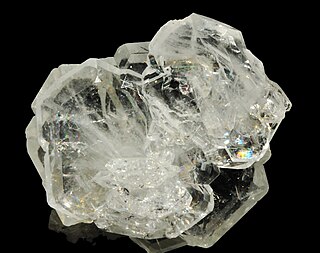
Goshenite is a colorless gem variety of beryl. It is called the mother of all gemstones because it can be transformed into other like emerald, morganite, or bixbite. Goshenite is also referred to as the purest form of beryl since there are generally no other elements present in the stone. The gem is used as imitation for diamond or emerald by adding colored foil on it.

Morganite is an orange or pink variety of beryl and is also a gemstone. Morganite is mined in Brazil, Afghanistan, Mozambique, Namibia, the United States, and Madagascar.

Red beryl, formerly known as bixbite and marketed as red emerald or scarlet emerald, is an extremely rare variety of beryl as well as one of the rarest minerals on Earth. The gem gets its red color from manganese ions embedded inside of beryllium aluminium cyclosilicate crystals. The color of red beryl is stable up to 1,000 °C (1,830 °F). Red Beryl can come in various tints like strawberry, bright ruby, cherry, and orange.

Aquamarine is a pale-blue to light-green variety of beryl. The color of aquamarine can be changed by heat.
